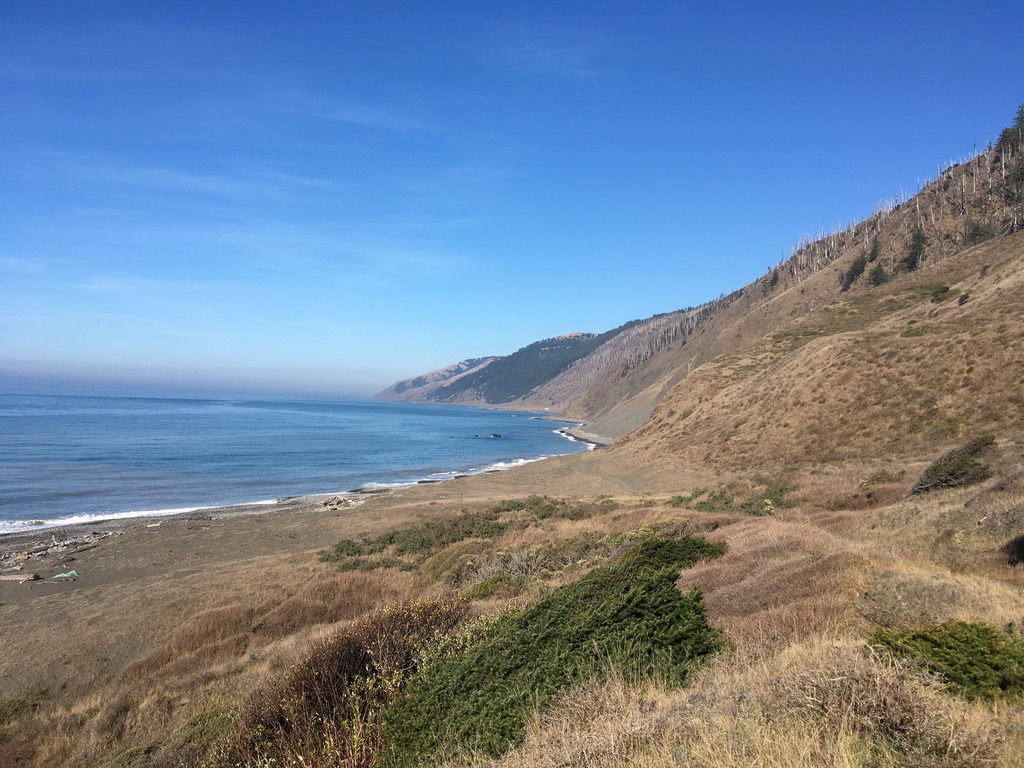
In 1936, the engineers constructing California’s Pacific Coast Highway rerouted their plans in Mendocino and Humboldt counties and turned the highway inland. The problem, they said, was the rugged, erosion-prone cliffs that would make the highway expensive and difficult to build. The result was a 50-mile stretch of undeveloped coastline that was left to wilderness and became known as the Lost Coast.
Lost. It brings to mind hidden places, mysterious and shrouded, and the Lost Coast is certainly that: shrouded in fog and rain for much of the year, difficult to arrive at, restricted to only a few visitors at a time.
Lost. It can also makes us think of opportunities missed, objects misplaced, friendships forgotten.
Lost. Unable to find one’s way.
But also, lost to the grips of civilization, lost to industry, lost to materialism, lost to the masses of mankind who see little purpose in braving discomforts or confronting their own minds. It is that sort of lost that I am after. For the mind is where I reside as I walk the sand alone, bandied about by the ebbs and flows of thoughts that rise and fall, crash and recede, like the waves beside me. Lost to the world, lost to expectations, lost even to the tight grip of my own constructed persona, I take a deep breath of ocean air and smile softly.
This is a place for solitude.
There are nine of us.
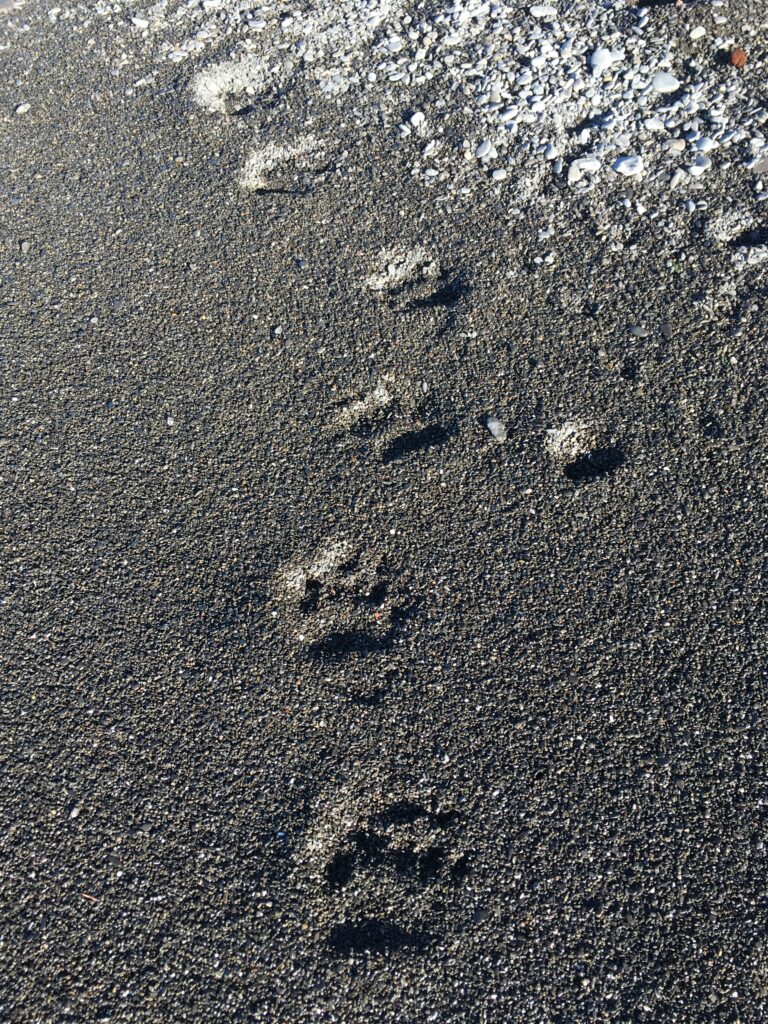
—
Two of us traveled North in the early hours of the morning the day before, through smoke and darkness, up highway 101, between burnt-out husks of lost houses, along stands of matchstick trees, remnants of the previous year’s Tubbs fire, the most destructive in California history at the time. I wore an N95 mask, though this was a year before COVID-19 would first appear, and two years before it would result in the sweeping loss of human life. It was not to protect my lungs from COVID, but from a different loss of life—the smoke of the Camp Fire that began two days prior and would eventually become four times as destructive as the Tubbs had been, in acres burned and human lives lost.
We approached in Shelter Cove an hour after sunrise, and joined seven who had already arrived. The cool, wet air was a refreshing change from the smoke that had plagued those early hours of driving. Conifer stands suspended canopies of mists above large-windowed houses, and an empty black-sand beach, scattered with driftwood and tangled seaweed, stretched out below.
We piled backpacks from four cars into two and clambered in to the spaces remaining. We followed long dirt roads between majestic coast redwoods, Douglas firs, and tanoak, wound our way along the low but rugged mountains of the King’s range, and splashed through creeks that would eventually feed into the Mattole River and the Pacific Ocean.
Along the way, we listened to the music of Andrew Bird and acquainted ourselves with one another. As the driver of the second car, I took it upon myself to open conversations, to catch up with friends I had not seen in some time and interrogate new friends I had not yet met, seeking connection and sounding them out to discover what sort of people they were.
Psychoanalyst Donald Winnicott theorized two selves: the true self is the authentic experience of being alive—the feelings of our bodies, instincts, and the joy of life. The false self is rooted in the expectations of other people, starting with one’s parents in youth and extending to other social relationships as we grow older. It is a shell, Winnicott says, constructed to defend the true self from manipulation and exploitation, but prone to leave the authentic self barren and unfulfilled.
My purpose, in questioning these men, was to find the shape and hardness of their false selves—How did they present themselves? How vulnerable were they already willing to be?—and if possible, to begin to give them enough comfort to lower defenses and expose their true selves. It was also selfish—if they could not open up, I would struggle too.
A bumpy hour later, we pulled into the Lightning trailhead, buzzing about with the final preparations that precede a hike.
—
The shadow of the earth displays purple above the horizon. It is before dawn that I walk the beach alone. Months of uninterrupted backpacking experience has allowed me to hone my morning pack-up routine down to a few minutes where others may take a half hour or more, and I use the extra time to explore the beach alone. We arrived here after dark last night, so this is my first visual experience of the beach itself, and I want to see whether my other senses have given me a good measure of it. I walk slowly and match the speed of my footsteps, if not exactly to the rhythm of the ocean, then to its mood.
The sand is soft and downy, giving several inches under each footfall with the softness of fresh snow. I tread past huts and teepees assembled ad-hoc out of driftwood—which might have been assembled yesterday or a hundred years ago—down to the wet sand that forms one small stretch of the ebbing intersection between the Pacific Ocean and the North American land mass.
Looking out to the ocean, I try to imagine a place where three tectonic plates come together under the sea. The North American, the Pacific, and the Gorda plate, which is a remnant of the Farallon plate that piled island chain after island chain into the California coast and, in sublimating itself, raised California mountains. The King’s range behind me is one consequence of that collision, a low but steep uplift that culminates in King’s Peak, a modest 4091 feet. The black sands are another of those consequences, formed from greywacke and compressed shale that was formed by the tectonic activity and has been brought up and pulverized into fine grains by the pummeling. I cannot find the convergence of tectonic plates with my eyes, of course; water is a universal level as effectively as it is a universal solvent.
Bear tracks wander the tide line, dipping out of existence where waves have erased them from the sand. They are larger and rounder than a human’s feet, but close enough in resemblance to create a sympathetic bond, a sense that the bears share our appreciation for the waves, for wandering, for solitude. I follow them for a short while north, feeling the breathing of the ocean on my left, sensing the stability of the earth on my right. After a time I slow my steps, not wanting to get too far away from camp. My eyes trace the visible coast to a point that obscures the rest.
The boundary between the ocean and the land is unknowable in its entirety. Even if one could trace the entire coast, whether by foot or by boat, the ebbing tides, pounding waves, and abrupt landslides change the contours continually. Yet a part can stand meaningfully for the whole, and a visit to relatively untouched coast, if approached with awareness and respect, can reveal much about the boundary as a whole.
Such is the liminal boundary between our true and false selves.
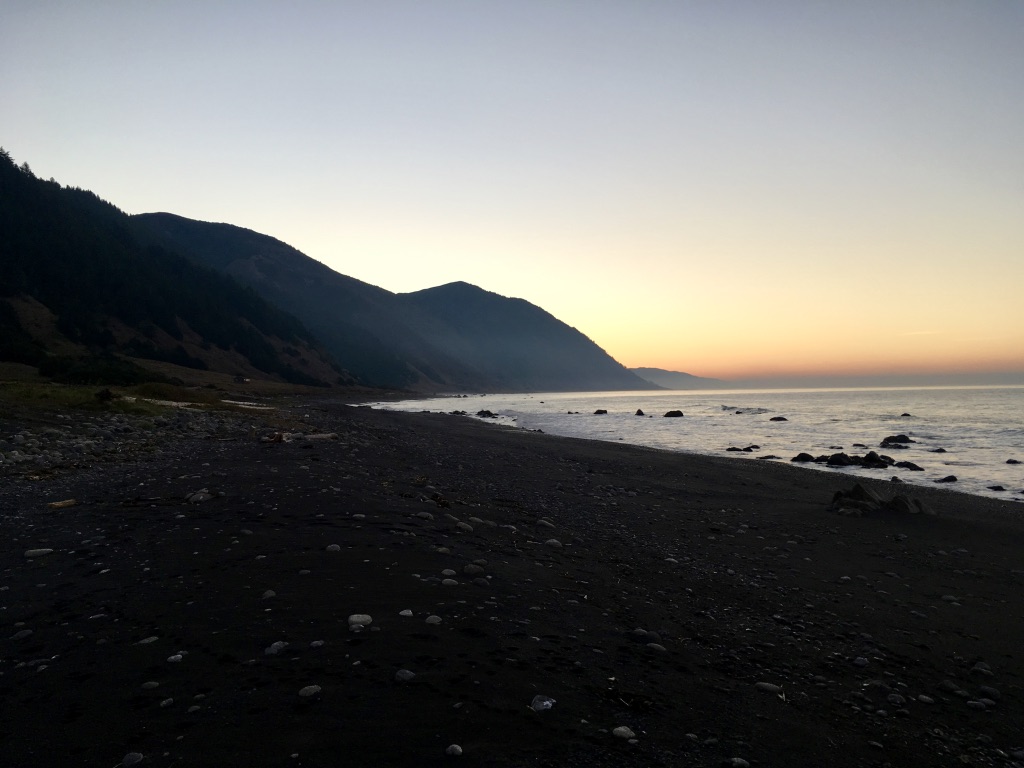
—
The movement at camp is beginning to increase, so I return the way I came. The nine of us make separate breakfasts in our separate pots on our separate stoves, but come together for conversation and laughter.
All nine of us are men, a dynamic that carries a different timbre. James, our trip leader, planned it this way, and although a society of men lacks elements of conversation and viewpoints that I would miss over a longer period of time, the trip is short enough—three days, of which one has already been spent—to keep me from feeling the absence of mixed company. There are elements to gain as well. Status concerns, while not entirely absent, are defanged; competition takes a milder, friendlier form, or is forgotten entirely. For myself, I would dispense with the whole of it, and I largely absent myself from the conversations, though I enjoy the gentle ribbing that passes between us all, and I am fond of all our cloister.
After breakfast we make our way down the coast in scattershot, some choosing to walk together, some apart. I make my way close to the water, trailing behind the others, to leave my prints among those of the bears and to enjoy the swish and crash of the waves.
The Mattole indians, who belonged to this land I walk, were cautious in their relations with the water. “Water watches you and has a definite attitude,” they warned, “favorable or otherwise towards you.”
Do not speak just before a wave breaks. Do not speak to passing rough water in a stream. Do not look at water very long for any one time, unless you have been to this spot ten times or more. Then the water there is used to you and does not mind if you’re looking at it. Older men can talk in the presence of the water because they have been about so long that the water knows them. Until the water at any spot does know you, however, it becomes very rough if you talk in its presence or look at it too long.
I don’t feel an unfavorable attitude, but it does feel as if the water is watching me, and I have no wish to speak before it. I am enjoying my solitude entirely too much to spoil it with my own sounds. Besides, what could I possibly add to the wisdom of the waves? Better to listen.
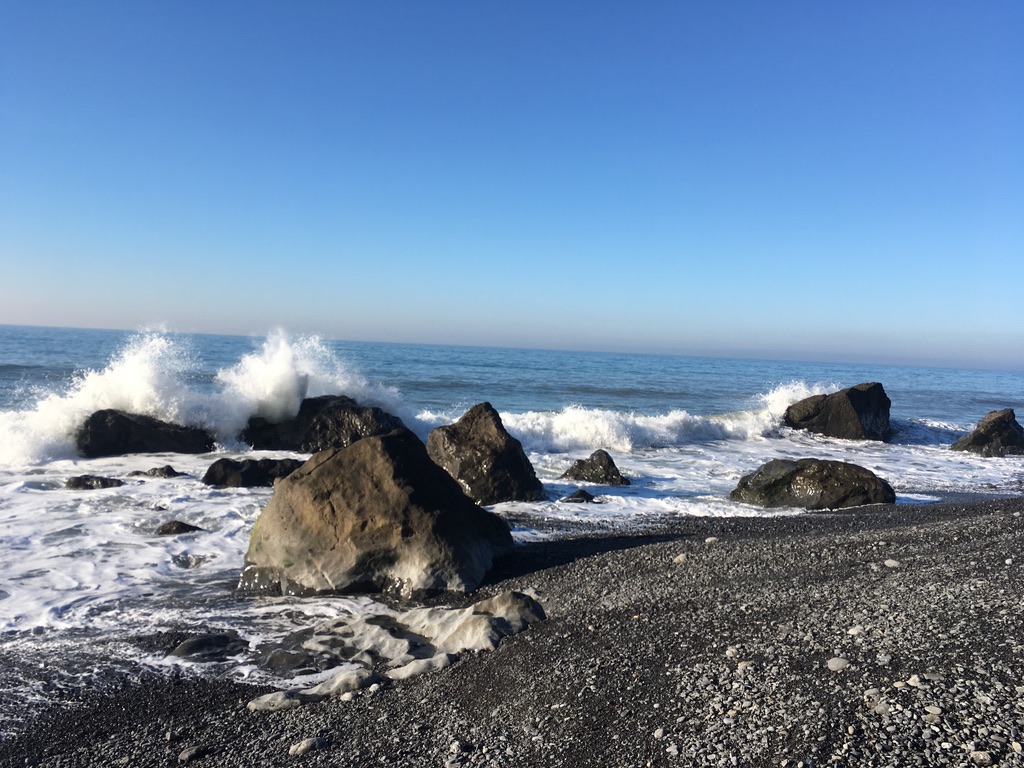
—
The Catholic monk and writer Thomas Merton once planned to build a hermitage on this coast. “The great Yang-Yin of sea rock mist, diffused light and half hidden mountain … an interior landscape, yet there,” He says. “In other words, what is written within me is there. ‘Thou art that.’” Merton spent his entire life looking for the authentic self, the “virginal point of pure nothingness which is at the center of all other loves.” His attempts were centered in his catholic religion, an attempt to know God by first knowing self, but he searched for it in the same way that all of us must: in solitude.
In his journals, Merton returns over and over to the dangers of society and civilization to the understanding of the authentic self. We use the trappings of civilization to hide our own emptiness, he says, to delude ourselves into believing in false selves built on “comfort, pleasure, and a good bank account”:
Those who love their own noise are impatient of everything else. They constantly defile the silence of the forests and the mountains and the sea. They bore through silent nature in every direction with their machines, for fear that the calm world might accuse them of their own emptiness. The urgency of their swift movement seems to ignore the tranquillity of nature by pretending to have a purpose.
Donald Winnicott describes the false self as an inability to feel spontaneous and real, a sense of emptiness, loneliness, and phoniness. We act in public the way we are expected to act; we put up a front of success, politeness, and good manners. Eventually we come to convince ourselves that this is who we really are, and we lose the spontaneous, authentic confidence of our true selves.
The antidote, Merton says, is to seek ourselves through solitary meditation and reflection:
The way to find the real ‘world’ is not merely to measure and observe what is outside us, but to discover our own inner ground. For that is where the world is, first of all: in my deepest self. This “ground,” this “world” where I am mysteriously present at once to my own self and to the freedoms of all other men, is not a visible, objective and determined structure with fixed laws and demands. It is a living and self-creating mystery of which I am myself a part, to which I am myself my own unique door.
The danger of the city, he says, is that it keeps us too busy, too distracted, to look inside and find our true selves. “The more we seem to accomplish, the harder it becomes to really dissimulate our trifling.” Instead, he counsels “Keep your eyes clean and your ears quiet and your mind serene. Breathe God’s air. Work, if you can, under His sky.”
Merton would die only a few months after his visit to the Lost Coast, so his planned hermitage never came to fruition. An aspirant hermit, if he wishes to practice here, must seek his solitude while breathing God’s air and working under His sky. But perhaps that was what Merton intended all along.
—
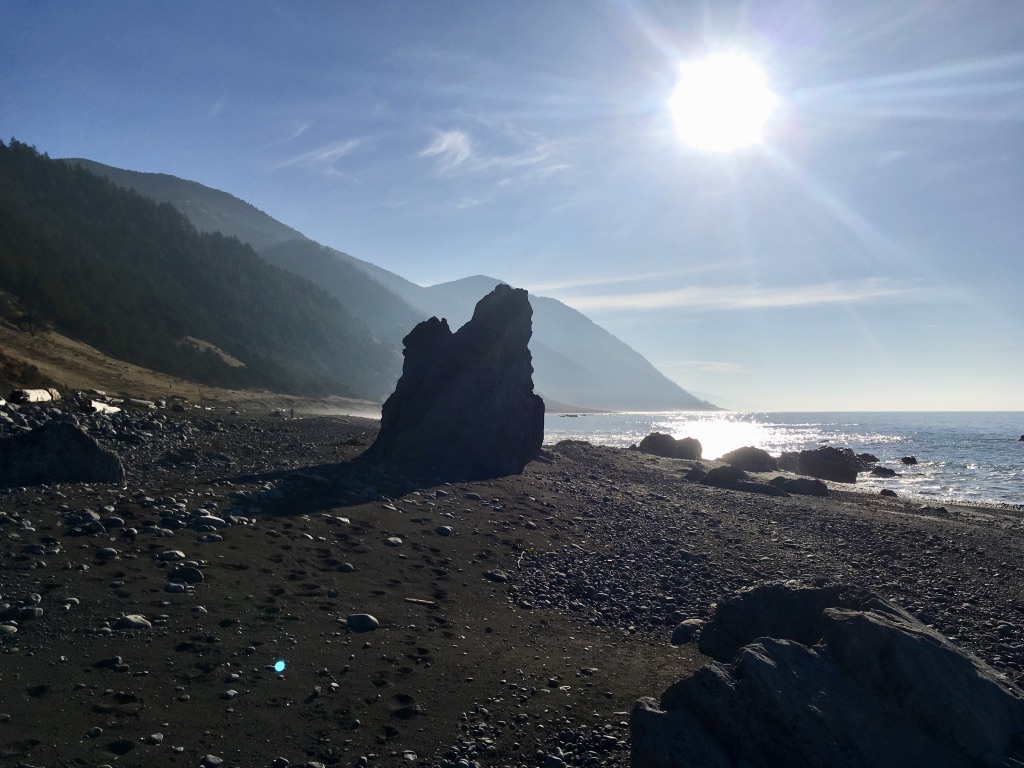
I catch up to the others, one and two at a time, and I walk with each of them for a short period. We comment on the light, which streams across the beach from between layers of redwood-carpeted mountain slopes; we remark on the bear tracks, which are so prevalent that we expect to encounter them at any moment; we sigh with the breezes, in communal appreciation of the mild weather and in recognition of a shared relaxation. Then I pass on, with the knowledge that a small piece of myself has been subtly altered with each interaction.
Eventually I find myself near the front of the pack, walking with my friend Konstantin. A clear stream has accumulated into a small pool here, lined with round stones, and he asks me if I want to take a dip with him. It’s an offer to connect, to share experience, but the day is cool and the water is cold, and my mind is so placid and calm that I don’t wish to risk a disturbance, so I decline and walk alone to the point.
My feet take me over a brow to a glittering new embayment. The face of the King’s Range is gauzily obscured by a brilliant haze of illuminated sea spray. With all of the others behind me in another cove, my solitude is complete.
—
For every thing, the book of Ecclesiastes informs us, there is a season.
Wilderness allows us to find solitude, and solitude is a prerequisite to discovering the authentic self, but the authentic self was never intended to remain alone. Solitude is a refuge, a way to retreat from the endless blows and battles with which others unintentionally hope to make us conform. It allow us to rest our defenses, gather our force, and choose our strategy with intent. Then we must reengage with the world, bringing the full force of our authentic selves to bear, and with the strength that only a true self can muster, shore one another up against the forces that would have us cower in inauthenticity.
“Solitude is impracticable, and society fatal,” Emerson tells us. “We must keep our head in the one and our hands in the other. The conditions are met, if we keep our independence, yet do not lose our sympathy. These wonderful horses need to be driven by fine hands.”
When we hold to our independence and the self-knowledge that comes from reflection in solitude, we give others permission to become their authentic selves. We bring to bear our vulnerability, our compassion, and our authentic belief that others have value as human beings, not because they are successful or have accumulated impressive titles and possessions, but simply because they are alive, and complex, and beautiful. It is work that can only be done person to person, in the midst of society.
On the other hand, when we have been in society for too long, our bright shine begins to tarnish, and we risk losing touch with ourselves. We cast about looking to others for direction and approval, not recognizing that each of them is similarly lost. Lost, in the sense of having gone astray. Lost, as in having misplaced our selves. Lost, as in forfeited or squandered. We have condemned ourselves to a hall of mirrors, reflection upon reflection and not a one real. We must come back to ourselves with a return to solitude.
—
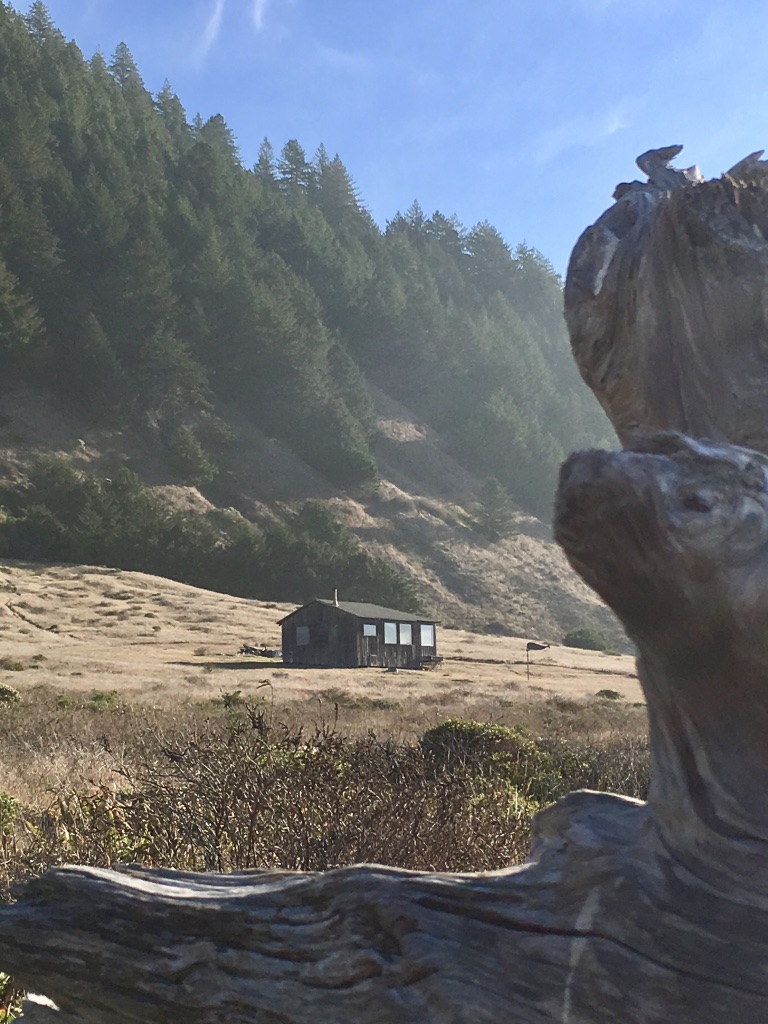
This wilderness coast has its houses, rare though they are. For the most part, they appear empty as I pass by. Some have fallen into disrepair, another loss of civilization that is really a gain. I finally stop to wait for the others just past a house that shows signs of occupancy—a full clothesline, adirondack chairs strewn with beach towels. Five deer graze a nearby meadow. Close to the water, four young men sit in the sand, watching a lone surfer. We each have our own ways of finding solitude, of hearing the wisdom of the wilderness.
I lean my backpack against a log, make my lunch, and watch as the surfer slices up and down a small, consistent break. Looking up the beach, I can see Konstantin already catching up, and behind him, one of our group who I hadn’t met before this trip. We will eat lunch together and wait a short time for the others. Tonight, we will all climb into the King’s Range, hike into the dark, and camp just below King’s Peak. Tomorrow, the nine of us will make our way back to the trailhead, split ourselves into two cars, talk and laugh with rowdy abandon as we travel the bumpy dirt road, split again into four, and make the long trip back to a civilization that is too sick to see that it is burning itself to death, and do our best to heal it with our authentic selves.
For one more moment, though, I have my solitude. I have the counsel of the waves, the steadiness of the mountains, and my self. May it be enough. May we each be enough.
If you enjoyed this, please leave a comment below!
I rarely write comments, but I loved this piece and it made me reflect on my true self. I appreciate and enjoy solitude whenever I want it (being retired allows me this) but I also need the compassion and acceptance of my authentic self from others which I miss during these Covid times. I continue to turn to Dr. Rick Hanson’s book, “Resilient” and “Buddha’s Brain” to Love my true self.
Thanks, Nick, you are a terrific writer.
Thanks so much, Shane. I haven’t picked up Resilient yet. Just another book to add to the list. It’s so true, we really need that acceptance of the authentic self from others in order to feel connected and valued. It’s so toxic when we feel like we can’t share that part of ourselves, and equally painful when there’s no one there to recognize and appreciate it.
Really like the idea of an untouched coast where people choose between their different selves! And water and tectonic plates, weaves interesting ideas together.
Oddly reminds me of the movie Stalker where people walk through a post apocalyptic world having philosophical conversations, they are trying to find a room where their deepest wish will come true– only thing is many people don’t know a part of themselves and so their deepest wish is pretty unknowable/a surprise.
Sounds like an interesting movie, thanks for the recommendation Caroline.
This is really lovely! You weaved your story and the landscape together so well, and the quotes you chose were perfect. And I love Winnicott; I only discovered him last year, though, and there’s so much more to learn about him and his ideas.
Thanks so much Aaron, really glad you enjoyed it.